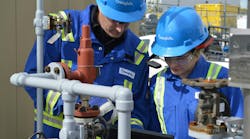The market for sewage transport will expand by 27,000 MGD from 2010 to 2015, according to a report by McIlvaine Company. During this same timeframe, the amount of wastewater treated with mechanical separation (primary treatment) is expected to grow by 16,000 MGD, while secondary treatment (biological) capacity is expected to reach 160,000 MGD, a 15,000 MGD increase. McIlvaine predicts secondary treatment capacity in the Middle East will grow 23 percent, while Asia is expected to account for over 33 percent of secondary treatment capacity by 2015.
Pumps and valves are used in transport and both primary and secondary treatment. As such, McIlvaine believes the municipal wastewater valve market will grow to $4.4 billion in 2015, while the pump market will be even higher reaching $8.8 billion.
Centrifuges and clarifiers are used in primary and secondary treatment. As such, McIlvaine predicts the world market for centrifuges in this application will rise to $207 million in 2015. The market for clarifiers and thickeners will be $837 million. The market for all sedimentation and centrifugation equipment for this application is expected to $1.1 billion.
Belt filter presses and drum filters are used to dewater municipal sludge. As such, McIlvaine predicts the world municipal wastewater sector will spend $568 million for belt filters in 2015. Filter presses and drum filters are also used for dewatering. The total macrofiltration revenues for municipal wastewater in 2015 will be $1.2 billion.
Cross-flow membrane filtration is being increasingly used to make municipal wastewater reusable. Countries such as China with very low rainfall per capita are taking advantage of this new source. As such, McIlvaine predicts 2015 revenues for cross-flow membranes and equipment for municipal wastewater will reach $415 million, with $150 million for micro-filtration and the balance for ultrafiltration and reverse-osmosis technologies.
According to McIlvaine, the world”s municipal wastewater plants will spend $4.5 billion for treatment chemicals in 2015. Of this total, $1.3 billion will be spent on inorganic coagulants while $1.8 billion will be spent for organic flocculants. Nearly $600 million will be spent for odor treatment chemicals.
McIlvaine predicts odor control solutions will also include a $1.6 billion investment in scrubbers, adsorbers, and biofilters. $800 million will be spent for absorber systems and $450 million for biofilters.

